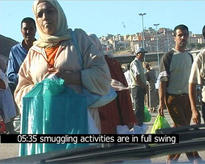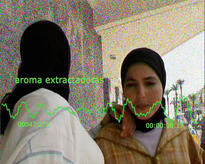EUROPLEX
’Europlex’, made in collaboration with visual anthropologist Angela Sanders, is a video which looks at the Spanish-Moroccan borderlands. What we can call the border there is not a linear formation. It encompasses the Straits of Gibraltar with all its transversal traffic, the two Spanish Enclaves on the Moroccan side, and the plastic-covered vegetable plantations in Andalusia powered by an African labor force. The video concentrates on the varied need for mobility for this area, as well as the different ways in which the specific area of the Straits of Gibraltar and the regions bordering it are given cultural meaning only by being crossed. The videographic recordings which we call ’’border log’’, relate to the two distinct sites Ceuta (’border log I + II’) and Tangier (’border log III’). We use the term “log” to link the travel logs and the ethnographic recordings with the practice of video editing, in which the log, i.e. the chronological list of the filmed material, is considered an indispensable preparation for the montage. ’Europlex’, particularly in the first border journal, visualises the observation process by describing just what it does, namely accurately registering the spatial-temporal process. It introduces a time, which allows an unhurried interpretation of the event, a temporal mode beyond the visual. Video becomes a cognitive tool. ’border log I’: smuggling - a cartography of struggle. The site is the border between Morocco and the Spanish enclave-city Ceuta, embedded in an otherwise entirely Moroccan landscape. Smuggling is an integral part of the daily border culture which is performed, for the most part, by Moroccan women. Venturesome and with economic calculation, they have established a high-risk, clandestine transaction system based on mutual trust. Circumscribing the architecture of the authorities up to eleven times a day, they inhabit the border in a non-linear, circular way, carving out an existence for themselves. In the interests of achieving the best possible mobility for crossing, the female smugglers strap shirts and cloths to their body, layer by layer, until they have doubled their body volume. Every piece will increase the profit margin of her passage. The economic logic inscribes itself onto every layer of the transforming, mobile, female body. ’border log II’: living in a time lapse. Another repetitive movement that marks the border between Ceuta and Morocco is the daily commute of the domesticas, the Moroccan maids who work in Spanish households in the enclave. Since the two bordering areas are located in distinct time zones with a time lag of 2 hours, the maids become permanent time travelers within the border economy. Deferred time becomes the mode of their cultural positionality. ’border log III’: entering the generic zone transnationalism. This last part moves into the transnational zone in North Africa where biological, textile and technological products are being manipulated for the European market. Subcontracting enterprises in Tangier with generic name inventions like Boratex, Sotema, Europlex or Sotradex intersect container shipments from West Africa on their way to Mediterranean or North European destinations, invisibly servicing and conforming goods to Euronorm standards. (Source: https://www.geobodies.org)



- Format miniDV(miniDV)
- Color system PAL
- Color col. and b&w
- Year 2003
- Duration 00:20:00
- Languageinfo
Subtitles: English UK
Running text/titles: English UK
Spoken: Arabic, English UK
-
Artists
-
EVENTS